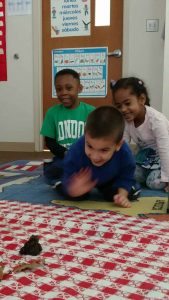 In February, the lives of Logos preschoolers were changed when a special guest came to visit. His name was Snowflake Sunshine Shoelace III. This special guest came to show them about biology and the natural world. He won their hearts in the process. Not a day has passed since his first visit that a Logos preschooler doesn’t ask about Snowflake.
In February, the lives of Logos preschoolers were changed when a special guest came to visit. His name was Snowflake Sunshine Shoelace III. This special guest came to show them about biology and the natural world. He won their hearts in the process. Not a day has passed since his first visit that a Logos preschooler doesn’t ask about Snowflake.
This special guest, Snowflake Sunshine Shoelace III, is a toad. Snowflake has also become a celebrity. At least to the 30 preschoolers at Logos.
With the help of his friend and Logos science teacher, “Miss Colleen”, Snowflake has done three important things for these little boys and girls:
- He made biology real to them.
- He helped them think critically while having fun.
- Perhaps most importantly, he awakened their curiosity.
Making Science Come Alive
Miss Colleen showed Logos’ young scientists how to observe. Preschoolers can observe similarities and differences between toads and frogs. For example, both have ears which are flat “like trampolines”, something most of the kids could relate to. But toads can crawl, while frogs can’t. Toads jump, but frogs jump further. The kids learned these and other fun facts about frogs and toads.
To see if Snowflake would move, the children were encouraged to be patient and quiet (a challenge for them!). “He becomes more real if he moves,” Miss Colleen explains. When Snowflake felt comfortable enough to explore, the children saw him hop and eat mealworms. They discussed how he moved and behaved when he was frightened or relaxed.
Thinking Critically, Connecting Dots
Hopping and eating opened up so much fun conversation for the kids! If Snowflake eats, does he have to wash his hands? Wait! Snowflake doesn’t have hands! So does he need to wash his tongue? Seeing Snowflake’s daily life and talking about it helped the chil dren think about his needs and compare them to what they do.
dren think about his needs and compare them to what they do.
The children learned how Snowflake lives and constructed toad houses. They applied their observations of Snowflake’s habits and behavior to decide what kind of houses to build. They took their job seriously, carefully considered what Snowflake would need in an appropriate home. One 4-year old even insisted he bring the toad house back to school in case “Snowflake needed it”.
Feeling connected to Snowflake also engaged the children with the classic short story, Frog and Toad Are Friends, which they read in another class. The friendship between Frog and Toad highlights life-examples, feelings and interpersonal connections. The kids surprised Miss Colleen and the other teachers by how much they took to the story.
Awakening Curiosity
After science, it’s time for recess. One Thursday after the kids watched Snowflake to see if he would eat, little Joe approached Miss Colleen on the playground.““Miss Colleen,” he said, “I have a few more questions about the toad.” “It was loud in there before. I wonder if Snowflake is hungry now.” So Miss Colleen took Joe back in the building to find out. Miss Colleen believes it’s important to follow a child’s conversation where it leads because
“You know they’re learning if they are still digesting after you’ve stopped teaching.”
Sparking curiosity is perhaps the most important thing Snowflake gave the little scientists at Logos. They told their parents about him at home, wondered if he was ok after a recent wind storm and look at their own worlds a little differently now.
Logos loves cultivating curiosity because it is a thread that can lead to life changing places when pulled correctly. One of the world’s greatest scientists said it this way:
“I have no special talents, I am only passionately curious.” – Albert Einstein
Get to Know Miss Colleen and Snowflake
Snowflake found Miss Colleen on a cold February night after several unseasonably warm days. Earlier that day she and the Logos kids had been wondering what happens to amphibians who hibernate when weather changes drastically. They noted that frogs and toads cannot quickly switch back and forth into heat-saver mode.
In this respect, Snowflake has proven to be a toad of exquisite timing. He hopped into Miss Colleen’s life as she held the door open to a school science fair. Since then he has settled nicely in a warm 10 gallon aquarium while he awaits more toad-friendly weather.
Snowflake is an American Toad who likes to sing back to the oven timer and YouTube videos of other toads singing. He was named by kindergartners in one of Miss Colleen’s after school science programs.
Miss Colleen, aka Colleen Danner, is an architect by training but a teacher at heart. Originally from Michigan, she taught ice skating in college. Miss Colleen fell into science because of her eldest son, who is autistic. Helping him explore and navigate the world made her his teacher by default. And science was something he loved. Miss Colleen later worked as an aide to Karleen Boyle, a marine biologist who led an afterschool science program for many years and now runs The Science Place.
Miss Colleen says the special experience with her son helps her to think “sideways”. This ability to flow with the direction of a child’s thinking and mood is invaluable in teaching preschoolers. Miss Colleen loves to experiment and learn, make 2 and 3-D art from everyday objects, and make chalk art on her driveway with her own kids. She likes working at Logos “because it’s so unique”.
Make Science Come Alive Where You Are
Kids learn when they’re having fun and things become real to them. Would you like to bring science to life in your home? Check out these science tips for busy parents. Miss Colleen also suggests seven ways you can engage your kids in science:
- Ask them questions, then value their answers.
- Explore and wonder together.
- Congratulate curiosity.
- Color happily outside the lines.
- Don’t be afraid to spill the glue when doing projects.
- Remember to have fun!
- If something can’t be fun, find a way to make it satisfying.
Do you have any tips or great experiences for bringing science to life? We’d love to hear them!

